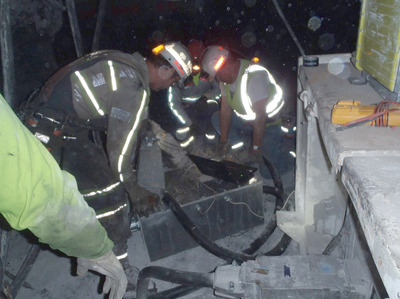Improving power quality at mine sites
Ongoing discussion on the effect of variable voltage, variable vrequency (3VF) drives (VFDs in the US) on coal mining power systems has received some clarification with recently collected data.
A project within the CRCMining Power Management program based at the School of Electrical Engineering at the University of Newcastle has collected voltage and current information in an underground offshore coal mine at the substation (power centre) level into which the mine’s continuous miners are connected. The work is part of an investigation into voltage stability and its effects on both production and maintenance. The data collection box, designed and built in Australia by the University of Newcastle, collected information well over the 100th harmonic in an attempt to capture transients associated with switched power factor correction capacitors and harmonics associated with variable speed AC drive units not fitted with active front end filters.
Modelling of a target mine in CRCMining’s ‘Statcom’-based voltage stabilisation project had indicated significant voltage transients would be found as a result of switched capacitors and this was proved to be both correct and accurate. However, the level of harmonic distortion was substantially higher than had been anticipated and is now the subject of further studies.

A quick analysis of the collected data indicates very high levels of 5th, 7th and 11th harmonics, which can considerably decrease the life of both power system components such as transformers and connected motors due to heating. Contributing components to these harmonics may include variable speed AC drives as well as core saturation of transformers in the system, which was previously not considered in the mix of potential issues. Overvoltage transients of 600 V were measured, associated with capacitor switching, and undervoltage issues associated with line impedances have been verified, validating the mine model developed by the university for the Statcom project. An interesting question raised by the results is whether a ‘stiff supply bus’ would have any effect on the data. While heavy dynamic loading of weak supplies will cause voltage fluctuations for equipment, the observed harmonic distortion could be generally unaffected by the stiffness of the connecting supply considering the line impedances between miners and their grid interconnect.
Electrical engineers in mining have welcomed the results, which they believe are very timely given the industry’s rate of adoption of variable speed AC drives. It is believed increased nuisance tripping of conveyor belt drives and earth leakage detection failures are possible outcomes of not fully understanding the dynamics of the underground mining power distribution system as well as the obvious maintenance and life cycle issues of equipment.
Current work is focused on three main areas: developing a range of predictive condition monitoring tools (DC and AC motor duty meters and novel power quality measuring tools); identifying power supply and reticulation weakness to understand their effect on production and equipment, then providing voltage support and harmonic correction solutions; and, extending the interoperability capability of the CRCMining Power Management group by using mine precinct data to determine the key elements of mixed energy generation, with a view to optimising operational cost, power delivery capacity and power quality. Mine planners will be able to draw metrics for the development of power systems and researchers can focus on issues affecting operational capabilities to provide new and innovative solutions to optimise energy delivery and cost.
The second area aims to understand mine precinct power requirements driven by diurnal, shift, week/weekend, seasonal and product impacts, and matching this varied demand with grid supply options. This includes an assessment of interoperability between conventional, renewable and hybrid supply solutions.
CRCMining conducts projects within a number of key research, development and demonstration programs with its members. The programs currently span the areas of automation, power and equipment management, rock fragmentation and handling, and coal technology and fugitive emissions.
CRCMining members come from mining end users (Anglo American, AngloGold Ashanti, Barrick Gold Corporation, BHP Billiton, Newcrest Mining, Newmont Mining, Peabody Energy and Xstrata Coal), original equipment manufacturers and service providers (Caterpillar, CSC, Herrenknecht, Joy Global and Sandvik) and from the research providers at the Universities of Newcastle, Queensland, Western Australia and Curtin University.
www.crcmining.com.au
Can cathodic protection design support ESG outcomes?
Omniflex's David Celine explains how CP system design can support environmental, social and...
Designing a robust cable for aquaculture
To ensure the health of farmed marine animals, the components of an aquaculture system must work...
Protecting your enclosures from environmental hazards
Ingress Protection (IP) ratings provide valuable information about the protection level of an...



